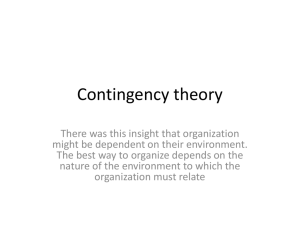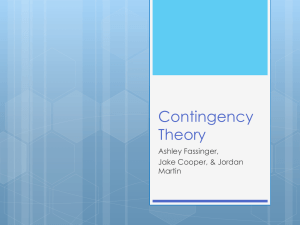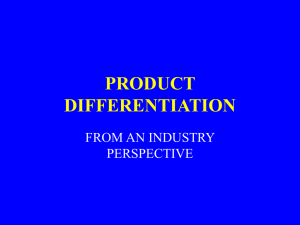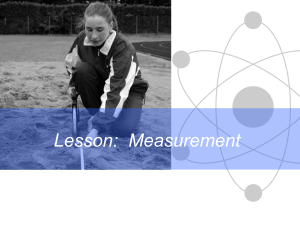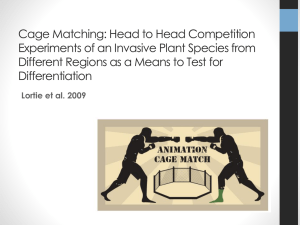Science in management2
advertisement
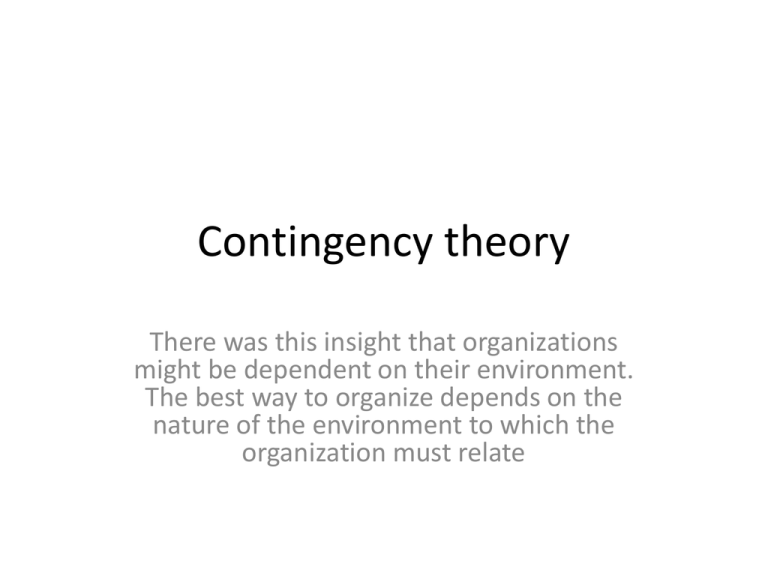
Contingency theory There was this insight that organizations might be dependent on their environment. The best way to organize depends on the nature of the environment to which the organization must relate The history of management thinking; a diachronic perspective • Pioneers • The late 19th century… B&K suggest ”Industrial Betterment” • Organization as a rational system –1930 • Organization as a natural system 1930 –1955 • Organization as an open system 1960 –1980 • Organization as a symbolic system 1980 – ? A pendulum perspective • The development of management thinking might be described as a repeated swing between organic and mechanic rhetoric • Considering Kondratievs idea about long waves in the economy Barley and Kunda suggest that the mechanic rhetoric dominates during periods of growth, and that the organic rhetoric dominates during periods of stagnation Organization as an open system • 1955/60 – 1980 • Organizations are not just closed boxes where you might manipulate as you please. They are open and dependent on their environment in ways that put harsh restrictions on the management. Organizations as organisms Organisms, like businesses, compete for survival and evolve to gain an edge. An organism is responsive to its environment, it can learn and adapt. Like organisms, businesses are born, grow and die. Organisms are more receptive to environmental feedback than machines. Businesses also operate within a delicate ecology with a lot of interdependencies. It's not as clear who's in charge of an organism as it is with a ship, however. Do businesses have no more control over their fate than animals facing evolutionary pressure? Living systems environmental conditions adaptation life cycles recycling needs homeostasis evolution survival of the fittest health illness Joan Woodward Joan Woodward • technologies directly determine differences in such organizational attributes as span of control, centralization of authority, and the formalization of rules and procedures. • There are three kinds of technology according to JW • Unit by unit • Mass production • Process industry Robert Blauner • ”Alienation and freedom” 1964 • Blauner claimed that alienation was closely connected to the organizational logic of mass production • Craft, mass production and process production related to alienation like an inverted U Henry Mintzberg Burns and Stalker • The Management of Innovation 1961 • Based on studies of the electronic industry I Scotland • The central theme of the book is the relationship between an organization and its environment - particularly technological and market innovations. • Internal structure must follow external contingencies Burns and Stalker • In their book they try to synthesise management thinking up to 1960 • SOP is ideal for repeated tasks, as in bureaucracy, but extensive regulations bring about narrow minded egoism • A natural organization loosens up the bureaucratic rigour and permits initiative and innovation • Change is the blind spot for bureaucratic rationalism Two kinds of management systems • Mechanistic – Functional differentiation – Hierarchy – Vertical communication – Instructions and decisions – Specified obligations and responsibilities • Organic – Specialized knowledge related to overall goals – Network structure – Lateral communication – Information and advice – Commitment Burns and Stalker • There are two kinds of environments – Stable and changing • And two kinds of internal organizational systems – Mechanic and organic • Firms working under stable conditions can be expected to succeed if they have a mechanic system • Firms working under changing conditions can be expected to be successful if they have an organic system • Burns & Stalker seem to expect more change in the future Lawrence and Lorsch • Differentiation and Integration, 1967 • Differentiation and integration is needed to adapt to the requirements of the environment. • How can an organization achieve both when they, in essence, are antagonistic • More of both will be needed as the environments will be both more heterogeneous and more dynamic Differentiation and integration • Units that have similar orientations and tasks should be grouped together. (They can reinforce each other's common concern and the arrangement will simplify the coordinating task of a common manager). • Units required to integrate their activities closely should be grouped together. (The common manager can coordinate them through the formal hierarchy). • Notice that when there is need for both more differentiation and more integration organizational complexity will rise Complex organization • Complex environments necessitated complex organizations • Lawrence and Lorch’s line of thought made matrix organization popular • Charles Perrow (1972) was worried that those big complex organizations that had emerged during the 19-hundreds were impossible to manage and threatened society. James D. Thompson I. Where both preferences and cause/effect relations are clear, decision making is "computational". These decisions are often short term and information about the decision is fairly unambiguous. II. Where outcome preferences are clear, but cause/effect relations are uncertain, Thompson suggest that "judgment" takes over and you make your best educated guess. These decisions are based on prior experience and are often qualitative in nature. III. When the situation is reversed, and preferences are uncertain, then you rely on compromise between different groups. Political coalitions may be built which rely on negotiating and bargaining. IV. When neither preferences nor cause/effect relations are clear, then you rely on "inspirational" leadership. This is where the charismatic leader may step in and this type of decision often takes place in times of crisis. James D. Thompson • An organization is dependent on the well functioning of its technological core • Signals and demands (disturbances) from the environment of the organization can put the well function of the technological core at risk • Rational organizations assign a variety of administrative units to deal with and neutralise the disturbances as a protective buffer for the technological core Hersey and Blanchard The fate of Contingency Theory • The empirical evidence of a correlation between fit and success is inconclusive • The idea of fit is somewhat circular • The notion of environments as given facts was questioned • But still; contingency theory has great face validity and is a dominating perspective in much of the literature about corporate strategy
